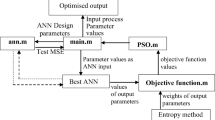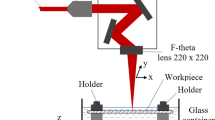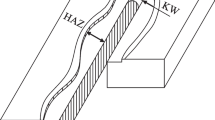Abstract
Laser machining has been emerging as a powerful alternative for cutting thin metal substrates. In this study, the application of pulsed laser cutting of a thin nonoriented silicon steel, with a thickness of 0.1 mm, was studied. The four processing parameters considered were laser power, cutting speed, pulse repetition rate, and processing environment. The two outputs to be measured were the extent of heat-affected zone (HAZ) and deviation of magnetic flux density (MFD) from initial value. Each input was designed with three levels and the three processing environments were air, deionized water, and sodium chloride solution. Based on the experimental design of the L27 Taguchi method, 27 parameter sets out of the total of 81 sets were used for the experiment. Results show that HAZ and MFD were negatively correlated. Compared with processing in air, cutting in the liquid could effectively reduce the HAZ. In the 27 experimental cases, the achieved minimum HAZ was 34.5 μm that corresponded to retaining 99% of initial MFD. The importance of the input was analyzed by the random forest method. The most and second significant parameters were laser power and environmental condition and their importance levels were 50.82% and 40.99%, respectively. Four artificial intelligence (AI) prediction models, full quadratic multiple regression analysis, artificial neural network, random forest, and extreme learning machine (ELM), were established based on randomly selecting 80% of the 27 data sets for training and the remaining 20% for testing. Model verification was executed by arbitrarily taking 10 additional new predictive parameter sets, from the remaining 54 parameter sets, for experiments. After comparing the predicting and experimental results, ELM model was found to have the best forecast performance. Thus, it was chosen as the target model for output optimization by the genetic algorithm method (GA). Through implementing the predicted optimal processing parameters from the resulting ELM-GA algorithm for the confirmation experiment, the obtained MFD and HAZ were 1.639 T and 30.41 μm, respectively, which were very close to that of the predicted optimal outputs, 1.640 T for MFD and 29.90 μm for HAZ.











Similar content being viewed by others
Data availability
All the data have been presented in the manuscript.
Code availability
Not applicable.
Abbreviations
- SS:
-
Silicon steel
- MFD:
-
Magnetic flux density
- HAZ:
-
Heat-affected zone
- AI:
-
Artificial intelligence
- MRA:
-
Multiple regression analysis
- ANN:
-
Artificial neural network
- RF:
-
Random forest
- ELM:
-
Extreme learning machine
- GA:
-
Genetic algorithm
- OAs:
-
Orthogonal arrays
References
Schoppa A, Schneider J, Roth J-O (2000) Influence of the cutting process on the magnetic properties of non-oriented electrical steels. J Magn Magn Mater 215-216:100–102
Belhadj A, Baudouin P, Breaban F, Deffontaine A, Dewulf M, Houbaert Y (2003) Effect of laser cutting on microstructure and on magnetic properties of grain non-oriented electrical steels. J Magn Magn Mater 256:20–31
Emura M, Landgraf FJG, Ross W, Barreta JR (2003) The influence of cutting technique on the magnetic properties of electrical steels. J Magn Magn Mater 254-255:358–360
Loisos G, Moses AJ (2005) Effect of mechanical and Nd:YAG laser cutting on magnetic flux distribution near the cut edge of non-oriented steels. J Mater Process Technol 161:151–155
Araujo EG, Schneider J, Verbeken K, Pasquarella G, Houbaert Y (2010) Dimensional effects on magnetic properties of Fe–Si steels due to laser and mechanical cutting. IEEE Trans Magn 46:213–216
Siebert R, Schneider J, Beyer E (2014) Laser cutting and mechanical cutting of electrical steels and its effect on the magnetic properties. IEEE Trans Magn 50
Hofmann M, Naumoski H, Herr U, Herzog HG (2016) Magnetic properties of electrical steel sheets in respect of cutting: micromagnetic analysis and macromagnetic modeling. IEEE Trans Magn 52
Naumoski H, Riedmüller B, Minkow A, Herr U (2015) Investigation of the influence of different cutting procedures on the global and local magnetic properties of non-oriented electrical steel. J Magn Magn Mater 392:126–133
Weiss HA, Leuning N, Steentjes S, Hameyer K, Andorfer T, Jenner S, Volk W (2017) Influence of shear cutting parameters on the electromagnetic properties of non-oriented electrical steel sheets. J Magn Magn Mater 421:250–259
Landgraf FGJ, Emura M (2002) Losses and permeability improvement by stress relieving fully processed electrical steels with previous small deformations. J Magn Magn Mater 242-245:152–156
Paolinelli SC, da Cunha MA (2006) Effect of stress relief annealing temperature and atmosphere on the magnetic properties of silicon steel. J Magn Magn Mater 304(2):e599–e601
Chiang CC, Knight AM, Hsieh MF, Tsai MG, Liu BH, Chen IG, Gaing ZL, Tsai MC (2014) Effects of annealing on magnetic properties of electrical steel and performances of SRM after punching. IEEE Trans Magn 50
Dickmann K (1990) Influence of the laser cutting process on the magnetic properties of electrical sheets. An Fis B 86(82)
Kai Y, Yoshida S, Enokizono M (2015) Influence of stress-relief annealing on magnetic properties of motor cores using induced current heating method. J Jpn Soc Appl Electromagn Mech 23:469–473
Muhammad N, Whitehead D, Boor A, Li L (2010) Comparison of dry and wet fibre laser profile cutting of thin 316L stainless steel tubes for medical device applications. J Mater Process Technol 210:2261–2267
Jain RK, Agrawal DK, Vishwakama SC, Choubey AK, Upadhyaya BN, Oak SM (2010) Development of underwater laser cutting technique for steel and zircaloy for nuclear applications. J Phys 75:1253–1258
Li L, Achara C (2004) Chemical assisted laser machining for the minimisation of recast and heat affected zone. CIRP Ann 53:175–178
Tsai MJ, Li CH, Chen CC (2008) Optimal laser-cutting parameters for QFN packages by utilizing artificial neural networks and genetic algorithm. J Mater Process Technol 208:270–283
Pandey AK, Dubey AK (2012) Simultaneous optimization of multiple quality characteristics in laser cutting of titanium alloy sheet. Opt Laser Technol 44:1858–1865
Madić M, Radovanović M (2012) Comparative modeling of CO2 laser cutting using multiple regression analysis and artificial neural network. Int J Phys Sci 7(16):2422–2430
Sharma A, Yadava V (2013) Modelling and optimization of cut quality during pulsed Nd:YAG laser cutting of thin Al-alloy sheet for curved profile. Opt Lasers Eng 51:77–88
Honarpisheh M, Mohammadi Jobedar M, Alinaghian I (2018) Multi-response optimization on single-point incremental forming of hyperbolic shape Al-1050/Cu bimetal using response surface methodology. Int J Adv Manuf Technol 96(9-12):3069–3080
Cica D, Kramar D (2019) Multi-objective optimization of high-pressure jet-assisted turning of Inconel 718. Int J Adv Manuf Technol 105(11):4731–4745
Khan MA, Jaffery SHI, Khan M, Younas M, Butt SI, Ahmad R, Warsi SS (2020) Multi-objective optimization of turning titanium-based alloy Ti-6Al-4V under dry, wet, and cryogenic conditions using gray relational analysis (GRA). Int J Adv Manuf Technol 106(9-10):3897–3911
Norkey G, Dubey AK, Agrawal S (2014) Artificial intelligence based modeling and optimization of heat affected zone in Nd:YAG laser cutting of duralumin sheet. J Intell Fuzzy Syst 27:1545–1555
Chelgani SC, Matin SS, Hower JC (2016) Explaining relationships between coke quality index and coal properties by random forest method. Fuel 182:754–760
Shahbazi B, Chelgani SC, Matin SS (2017) Prediction of froth flotation responses based on various conditioning parameters by random forest method. Colloids Surf A Physicochem Eng Asp 529:936–941
Abdullah SS, Malek MA, Abdullah NS, Kisi O, Yap KS (2015) Extreme learning machines: A new approach for prediction of reference evapotranspiration. J Hydrol 527:184–195
Mohammadi K, Shamshirband S, Motamedi S, Petković D, Hashim R, Gocic M (2015) Extreme learning machine based prediction of daily dew point temperature. Comput Electron Agric 117:214–225
Anicic O, Jović S, Skrijelj H, Nedić B (2017) Prediction of laser cutting heat affected zone by extreme learning machine. Opt Lasers Eng 88:1–4
Pandey AK, Dubey AK (2013) Modeling and optimization of kerf taper and surface roughness in laser cutting of titanium alloy sheet. J Me Sci Technol 27(7):2115–2124
Rao RV, Kalyankar VD (2014) Optimization of modern machining processes using advanced optimization techniques: a review. Int J Adv Manuf Technol 73(5-8):1159–1188
Tamrin KF, Nukman Y, Choudhury IA, Shirley S (2015) Multiple-objective optimization in precision laser cutting of different thermoplastics. Opt Lasers Eng 67:57–65
Saini SK, Dubey AK, Upadhyay BN (2019) Study and optimization of recast layer thickness and surface quality in laser trepan drilling of ZTA. Int J Adv Manuf Technol 103(5-8):2977–2989. https://doi.org/10.1007/s00170-019-03704-3
Rong Y, Zhang G, Chang Y, Huang Y (2016) Integrated optimization model of laser brazing by extreme learning machine and genetic algorithm. Int J Adv Manuf Technol 87(9-12):2943–2950
Madhav SP (1989) Quality engineering using robust design. Prentice Hall, New Jersey
Phillip JR (1996) Taguchi techniques for quality engineering. McGraw-Hill, New Delhi
Thin-gauge silicon steel strips, Nikkindenji kogyo Co., Ltd. http://www.nikkindenjikogyo.co.jp/english/company-english.html
Charee W, Tangwarodomnukun V, Dumkum C (2014) Laser ablation of silicon in water under different flow rates. Int J Adv Manuf Technol 78(1-4):19–29
Darwish S, Ahmed N, Alahmari AM, Mufti NA (2015) A comparison of laser beam machining of micro-channels under dry and wet mediums. Int J Adv Manuf Technol 83(9-12):1539–1555
Yilbas BS (2004) Laser cutting quality assessment and thermal efficiency analysis. J Mater Process Technol 155-156:2106–2115. https://doi.org/10.1016/j.jmatprotec.2004.04.194
Breiman L (2001) Random forests. Mach Learn 45:5–3
Mathew J, Griffin J, Alamaniotis M, Kanarachos FME (2018) Prediction of welding residual stresses using machine learning: comparison between neural networks and neuro-fuzzy systems. Appl Soft Comput 70:131–146. https://doi.org/10.1016/j.asoc.2018.05.017
Huang GB, Zhu QY, Siew CK (2006) Extreme learning machine: theory and applications. Neurocomputing 70(1-3):489–501
Wang ZH, Gong DY, Li X, Li GT, Zhang DH (2017) Prediction of bending force in the hot strip rolling process using artificial neural network and genetic algorithm (ANN-GA). Int J Adv Manuf Technol 93(9-12)
Laouissi A, Yallese MA, Belbah A, Belhadi S, Haddad A (2018) Investigation, modeling, and optimization of cutting parameters in turning of gray cast iron using coated and uncoated silicon nitride ceramic tools. Based on ANN, RSM, and GA optimization. Int J Adv Manuf Technol 101(1-4):523–548. https://doi.org/10.1007/s00170-018-2931-8
Funding
Financial support from Ministry of Science and Technology of Taiwan under Grant Numbers of MOST 109-2218-E-008-008 and 107-2218-E-008-018 is very much appreciated.
Author information
Authors and Affiliations
Contributions
Not applicable.
Corresponding author
Ethics declarations
Ethical approval
The article follows the guidelines of the Committee on Publication Ethics (COPE) and involves no studies on human or animal subjects.
Consent to participate
Not applicable.
Consent to publish
Not applicable.
Competing interests
The authors declare no competing interests.
Additional information
Publisher’s note
Springer Nature remains neutral with regard to jurisdictional claims in published maps and institutional affiliations.
Rights and permissions
About this article
Cite this article
Nguyen, T.H., Lin, CK., Tung, PC. et al. Artificial intelligence-based modeling and optimization of heat-affected zone and magnetic property in pulsed laser cutting of thin nonoriented silicon steel. Int J Adv Manuf Technol 113, 3225–3240 (2021). https://doi.org/10.1007/s00170-021-06847-4
Received:
Accepted:
Published:
Issue Date:
DOI: https://doi.org/10.1007/s00170-021-06847-4




